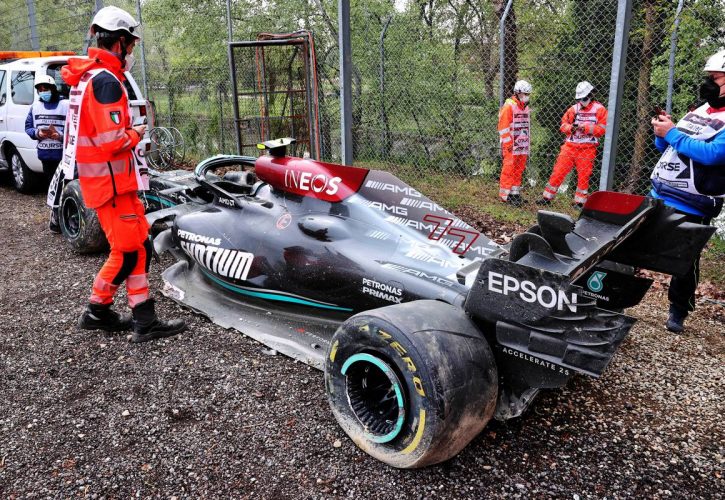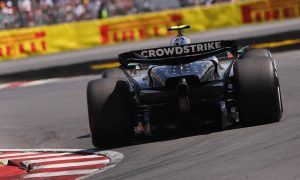
Mercedes has conducted an initial evaluation of the damage inflicted on Valtteri Bottas' car by the Finn's crash with George Russell in last weekend's Emilia Romagna GP, and concluded that a large part of the W12 is beyond repair.
Bottas was hit broadside by the Williams when Russell attempted to overtake the Mercedes driver on the run down to Tamburello.
The resulting contact sent both cars at full speed into the wall, fortunately with no physical consequences for their drivers. But the material damage was predictably heavy according to Mercedes trackside engineering director Andrew Shovlin.
"As much as we like our car, we like Valtteri more and happily he was able to come out of that with not much more than a bruised knee from the impact," said Shov, speaking in Mercedes video debrief on YouTube.
"It was a big crash, we were seeing around 30g at points in his trip around the walls and the track. Unfortunately, the car has not done quite so well. There is a fair amount of damage to that.
"We have managed to bring a lot of it back to the UK, we got the power unit at Brixworth where that’s being checked and inspected carefully, and we will just pick through this and some of the bits we might be able to salvage."
"Unfortunately, quite a lot of it is damaged beyond repair and we are just looking at a logistics plan to try and be able to get sufficient parts to Portimão, which is the week after next, to make sure we can run both cars in the correct spec."
Shovlin also detailed the reasons why Bottas struggled in the midfield and failed to move up the order, a problem that directly led to his crash with Russell.
"Valtteri was finding it hard to get close to other cars on the intermediate tyres, he was struggling for temperature, and that lack of temperature particularly early in the race just manifested itself as a lack of grip," explained the British engineer.
"In particularly for Valtteri, when he got close, as close as you would need to be to get a passing move, the front grip was dropping and he was washing out and couldn't really follow at a distance that would allow him to pass.
"The other factor was that in that intermediate stage, the DRS isn't enabled. And when you can get in the tow, when you can trigger DRS, you can actually gain around six tenths of a second just from the combined effect of those two things.
"So that was something that wasn't available to Valtteri at that stage which was to Lewis later on, but the key thing was really just the balance of the car, the understeer that he was picking up when he got close and the fact that that meant that he couldn't get the gap down to enough to launch an attack."
Gallery: The beautiful wives and girlfriends of F1 drivers
Keep up to date with all the F1 news via Facebook and Twitter






